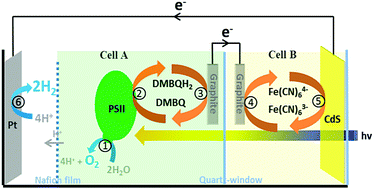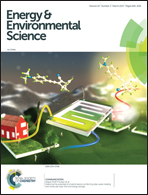Biomimetic electron transport via multiredox shuttles from photosystem II to a photoelectrochemical cell for solar water splitting†
Abstract
A bio-hybrid system integrating photosystem II (PSII) with artificial photocatalysts is considered as a platform to understand the solar-to-chemical energy conversion process. However, the electron transfer from PSII to artificial components remains inefficient, which hinders the favorable conversion performance. Herein, a CdS–PSII hybrid photoelectrochemical (PEC) cell is proposed for overall water splitting, where PSII and the CdS-based PEC cell are connected by an ordered multi-step electron transfer pathway comprising two redox shuttles quinone/hydroquinone and ferricyanide/ferrocyanide coupled by a graphite-based galvanic cell. The hybrid system allows overall water splitting with 8.5 μmol O2 h−1 and 17.7 μmol H2 h−1 under simulated solar light, corresponding to a solar-to-hydrogen efficiency of 0.34%. Moreover, the tandem light absorption from CdS to PSII both improves the light utilization efficiency and prolongs the lifetime of PSII. This work may inspire new approaches to achieve Z-scheme water splitting in the field of artificial photosynthesis.

- This article is part of the themed collection: 2017 Energy and Environmental Science HOT articles


 Please wait while we load your content...
Please wait while we load your content...